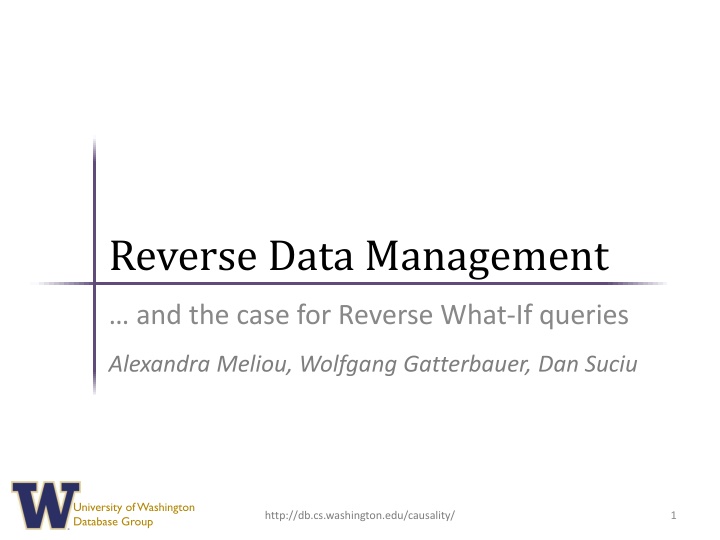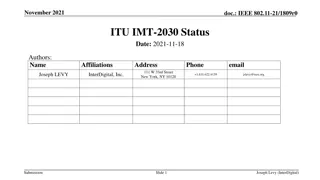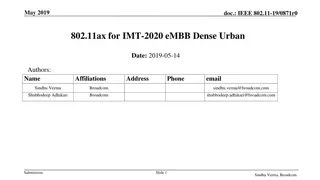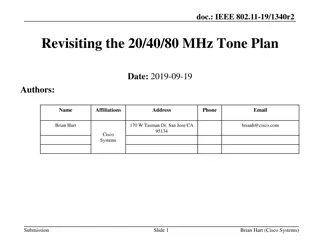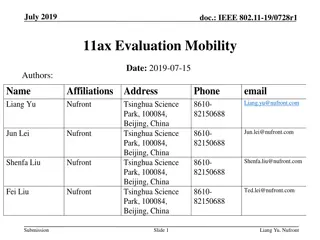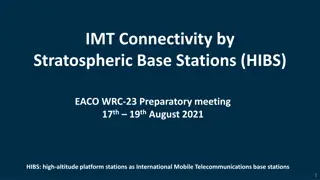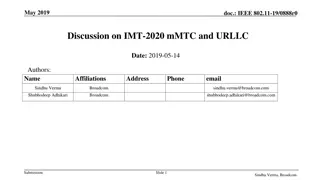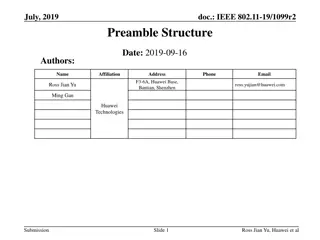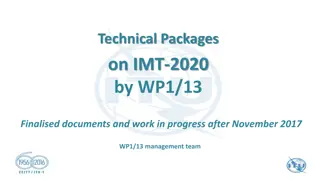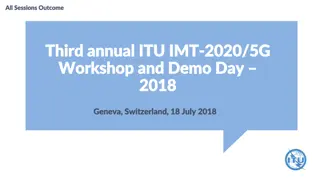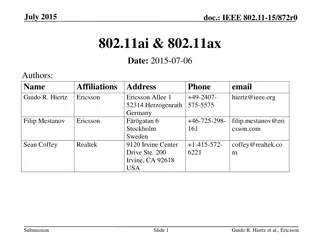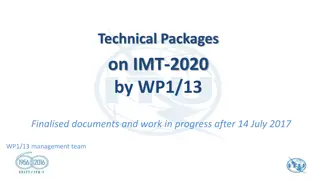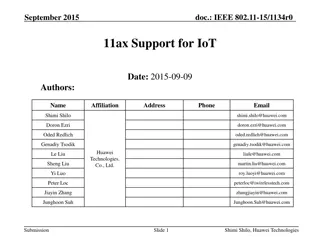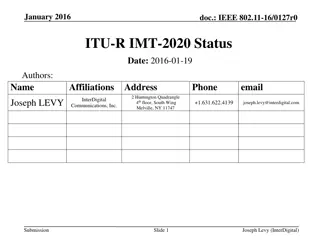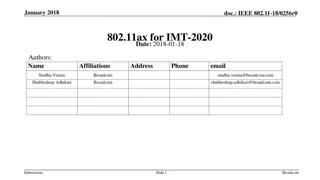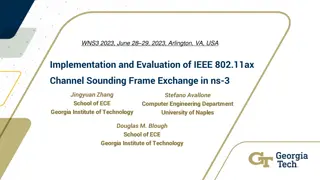802.11ax Capabilities for IMT-2020 Requirements
This document delves into the analysis of 802.11ax capabilities with respect to the IMT-2020 requirements for different scenarios like eMBB Indoor Hotspot and Dense Urban. It covers features in other unlicensed spectrum technologies and discusses the comparison of 802.11ax with LAA and MulteFire. The document also explores the parameters and desired ranges for 802.11ax in meeting the IMT-2020 requirements.
Download Presentation

Please find below an Image/Link to download the presentation.
The content on the website is provided AS IS for your information and personal use only. It may not be sold, licensed, or shared on other websites without obtaining consent from the author.If you encounter any issues during the download, it is possible that the publisher has removed the file from their server.
You are allowed to download the files provided on this website for personal or commercial use, subject to the condition that they are used lawfully. All files are the property of their respective owners.
The content on the website is provided AS IS for your information and personal use only. It may not be sold, licensed, or shared on other websites without obtaining consent from the author.
E N D
Presentation Transcript
Reverse Data Management and the case for Reverse What-If queries Alexandra Meliou, Wolfgang Gatterbauer, Dan Suciu University of Washington Database Group http://db.cs.washington.edu/causality/ 1
Forward and Backward Paradigm Forward transformations e.g: query processing, data integration, data mining, clustering, indexing Source data Target data http://db.cs.washington.edu/causality/ 2
Forward and Backward Paradigm Forward transformations e.g: query processing, data integration, data mining, clustering, indexing Source data Target data Backward transformations e.g: data cleaning, provenance, causality, data generation, view updates Reverse Data Management (RDM) http://db.cs.washington.edu/causality/ 3
The Problem Space of RDM Target Data Specific data instance, or diffs between versions e.g. before and after a view update explicit specification Described indirectly, through constraints and statistics e.g. declarative data generation implicit specification http://db.cs.washington.edu/causality/ 4
The Problem Space of RDM Target Data Source data needs to be modified in order to achieve the desired effect in the output e.g. view updates No source data is provided as a reference, but needs to be computed from scratch e.g. inverse schema mappings explicit specification implicit specification Source Data no source reference source http://db.cs.washington.edu/causality/ 5
The Problem Space of RDM modify the source data, to achieve the desired effect, while minimizing side-effects Target Data explicit specification View updates implicit specification Source Data no source reference source http://db.cs.washington.edu/causality/ 6
The Problem Space of RDM Target Data trace the source tuples that correspond to the target tuples of interest explicit specification View updates Provenance, Causality implicit specification Source Data no source reference source http://db.cs.washington.edu/causality/ 7
The Problem Space of RDM repair a data instance in order to satisfy a constraint Target Data explicit specification View updates Provenance, Causality implicit specification Constraint-based repair Source Data no source reference source http://db.cs.washington.edu/causality/ 8
The Problem Space of RDM Target Data explicit specification View updates Provenance, Causality Inversion mappings implicit specification Constraint-based repair Data Generation Source Data no source reference source http://db.cs.washington.edu/causality/ 9
Introducing Reverse What-If Queries Target Data explicit specification View updates Provenance, Causality Inversion mappings Reverse What-If or implicit specification Constraint-based repair How-To queries Data Generation Source Data no source reference source http://db.cs.washington.edu/causality/ 10
Hypothetical (What-If) Queries Change something in the source (hypothesis) forward Observe the effect in the target Example from [Balmin et al. VLDB 2000] An analyst of a brokerage company wants to know what would be the effect on the return of customers portfolios if during the last 3 years they had suggested Intel stocks instead of Motorola How would the target data change, given a change in the source? http://db.cs.washington.edu/causality/ 11
Reverse What-If, or How-To queries Find changes to the source that achieve the desired effect reverse Declare a desired effect in the target Modified example: An analyst wants to figure out how to achieve a 10% return in customer portfolios, with the least number of trades What is the best hypothetical scenario that achieves the desired outcome? http://db.cs.washington.edu/causality/ 12
Example (constraints) Company reorganization: A company going through financial strain wants to reduce operational costs by 10%, through: lay-offs, salary decreases, or department and project merging, (variables) within certain constraints specified by the company s requirements: (constraints) any salary decreases should be uniform across employees of the same department, every project should have at least a certain number of employee hours devoted to it, the solution should be achieved with the minimum number of employee reassignments (optimization objective) http://db.cs.washington.edu/causality/ 13
Declarative Problem Specification CREATE REPLACEMENT LineItem_N AS (SELECT FROM ok, pk, sk, VAR(quant) AS quant LineItem) Variable Definitions CREATE CONSTRAINT Constr1 AS NOT EXISTS (SELECT FROM GROUP BY ok HAVING ok, sum(quant ) AS c LineItem_N Problem constraints c > 100) CREATE OBJECTIVE Obj1 AS SELECT sum(*) FROM (SELECT quant quant FROM LineItem as L1, LineItem_N as L2 WHERE L1.ok = L2.ok, AND L1.pk = L2.pk AND L1.sk = L2.sk) Optimization criterion HOW TO SUBJECT TO Constr1 minimize(Obj1) Problem statement query http://db.cs.washington.edu/causality/ 14
System Architecture How-To Engine variables constraints objectives How-To parser How-To evaluation How-To query How-To answer DB http://db.cs.washington.edu/causality/ 15
System Architecture How-To Engine variables constraints objectives How-To parser How-To evaluation How-To query How-To answer User Input: Support variable, constraint and objective specifications Maintain declarativity DB http://db.cs.washington.edu/causality/ 16
System Architecture How-To Engine variables constraints objectives How-To parser How-To evaluation How-To query How-To answer DB Evaluation requirements: Efficiency! http://db.cs.washington.edu/causality/ 17
Evaluation LP reduction User Input 100 How-To Evaluation How-To answer LP/IP Map LP/IP solution to data LP/IP Solver transformation DB http://db.cs.washington.edu/causality/ 18
Conclusions Reverse Data Management Encompasses many important database problems Harder in general: the inverse of a function is not always a function How-To queries (reverse what-if) Implement optimization problems within a DBMS Plenty of challenges: Declarative input specification Efficient evaluation Optimization (combination of Integer Prog. and DB techniques) Under-specified and over-specified problem handling Solution stability and sensitivity http://db.cs.washington.edu/causality/ 19
